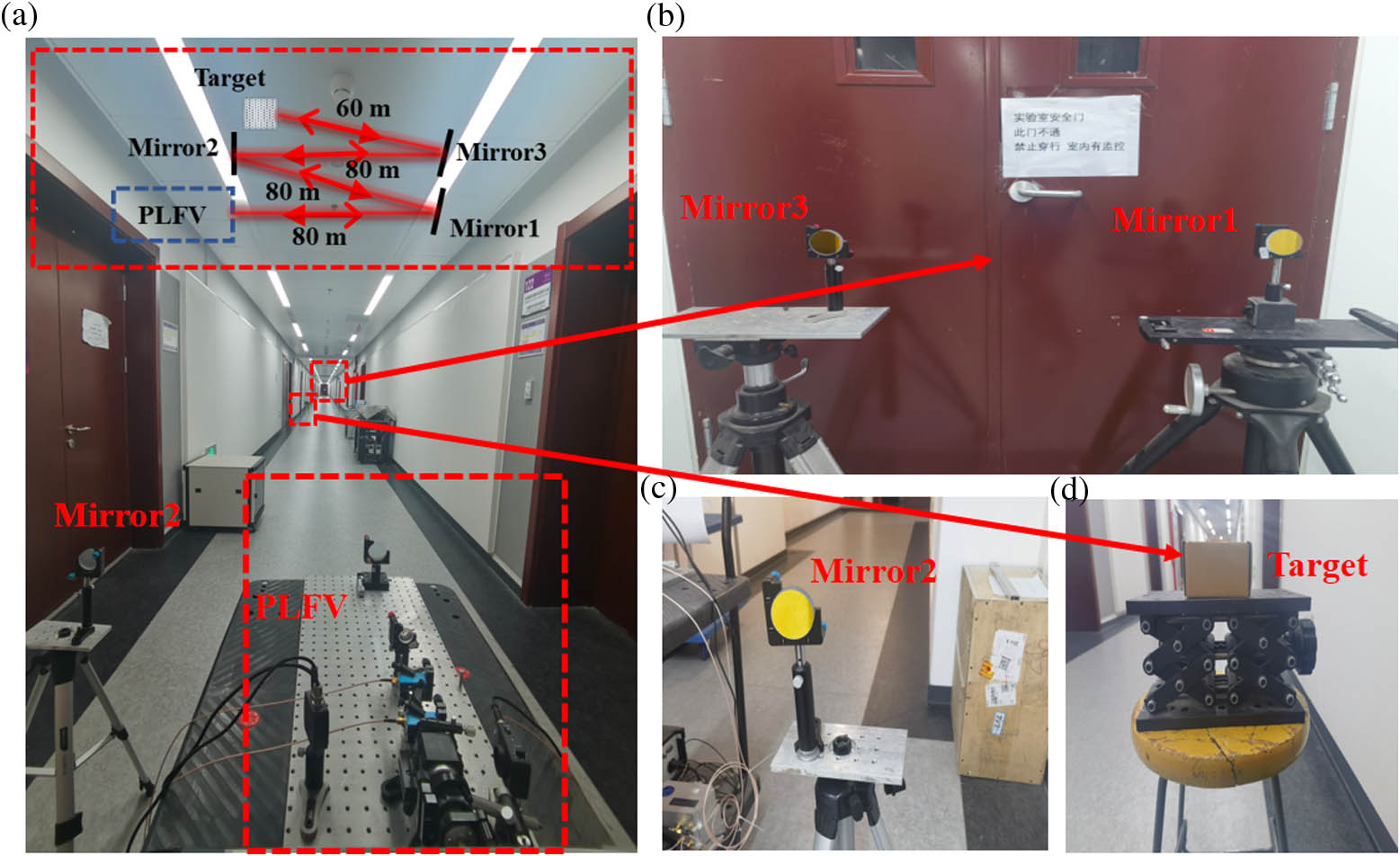Mingwang Tian, Xin Xu, Sihong Chen, Zhipeng Feng, Yidong Tan, "Ultrasensitive detection of remote acoustic vibrations at 300 m distance by optical feedback enhancement," Photonics Res. 12, 1962 (2024)
Search by keywords or author
- Photonics Research
- Vol. 12, Issue 9, 1962 (2024)

Fig. 1. Schematic diagram of the proposed PLFV. BS, 7:3 (transmittance:reflectance) beam splitter; L1, convex lens; FR, Faraday rotator; HWP, half-wave plate; AOM1, AOM2: acoustic-optic modulators; AP, aperture; L2, concave lens; L3, convex lens; QWP, quarter-wave plate; T, target; PD, photodiode.

Fig. 2. Physical device for the remote vibration measurement experiment. (a) Diagram of the PLFV, the mirrors used to turn the light path, and the target (a common carton) in the corridor, and inside the red frame is the overall schematic diagram of this long-distance vibration measurement experiment. (b), (c) Diagram of mirrors 1–3 used to turn the light path, which makes distance from the target to the PLFV reach 300 m. (d) Diagram of the target.
Fig. 3. Result of the signal spectrum for the target (a carton).
Fig. 4. Frequency accuracy test result. (a) Recovered spectrogram of the frequencies at 300 m. (b) Comparison between the measured frequency and the standard frequency. (c) Physical image of the target.
Fig. 5. Result of vibration amplitude response sensitivity. The y x
Fig. 6. Test diagram and results at different incident angles. (a) Schematic diagram of testing at different incident angles at 300 m. (b) Recovered spectrogram of the frequencies under 30 deg incidence condition. (c) Comparison between the measured frequency and the standard frequency under 30 deg incidence condition. (d) Recovered spectrogram of the frequencies under 45 deg incidence condition. (e) Comparison between the measured frequency and the standard frequency under 45 deg incidence condition.
Fig. 7. Schematic diagram of anti-wind interference test and test result of the PLFV. (a) Schematic diagram of test principle. (b) The recovered spectrogram of the frequencies in the presence of wind disturbances.
Fig. 8. Frequency accuracy test results of different targets and the targets’ physical images. (a) Recovered spectrogram of the frequencies of the PC plastic. (b) Comparison between the measured frequency and the standard frequency of the PC plastic. (c) Physical image of the PC plastic box. (d) Recovered spectrogram of the frequencies of the PET plastic. (e) Comparison between the measured frequency and the standard frequency of the PET plastic. (f) Physical image of the PET plastic bottle.
Fig. 9. Corresponding spectrograms of the demodulated voice signals obtained from an ordinary carton at distances of (a) 80 m, (b) 240 m, and (c) 300 m.
Fig. 10. Errors between measured frequency values and standard acoustic vibration frequency values at different light incidence angles (target as a carton at a distance of 300 m). The y x
Fig. 11. Errors between measured frequency values and standard acoustic vibration frequency values for targets with different materials (PC plastic and PET plastic). The y x
|
Table 1. Transmittance of Each Element of the PLFV
|
Table 2. Recognition Results under Three Different Distances
|
Table 3. Comparison of the Current Methods for Eavesdropping

Set citation alerts for the article
Please enter your email address



